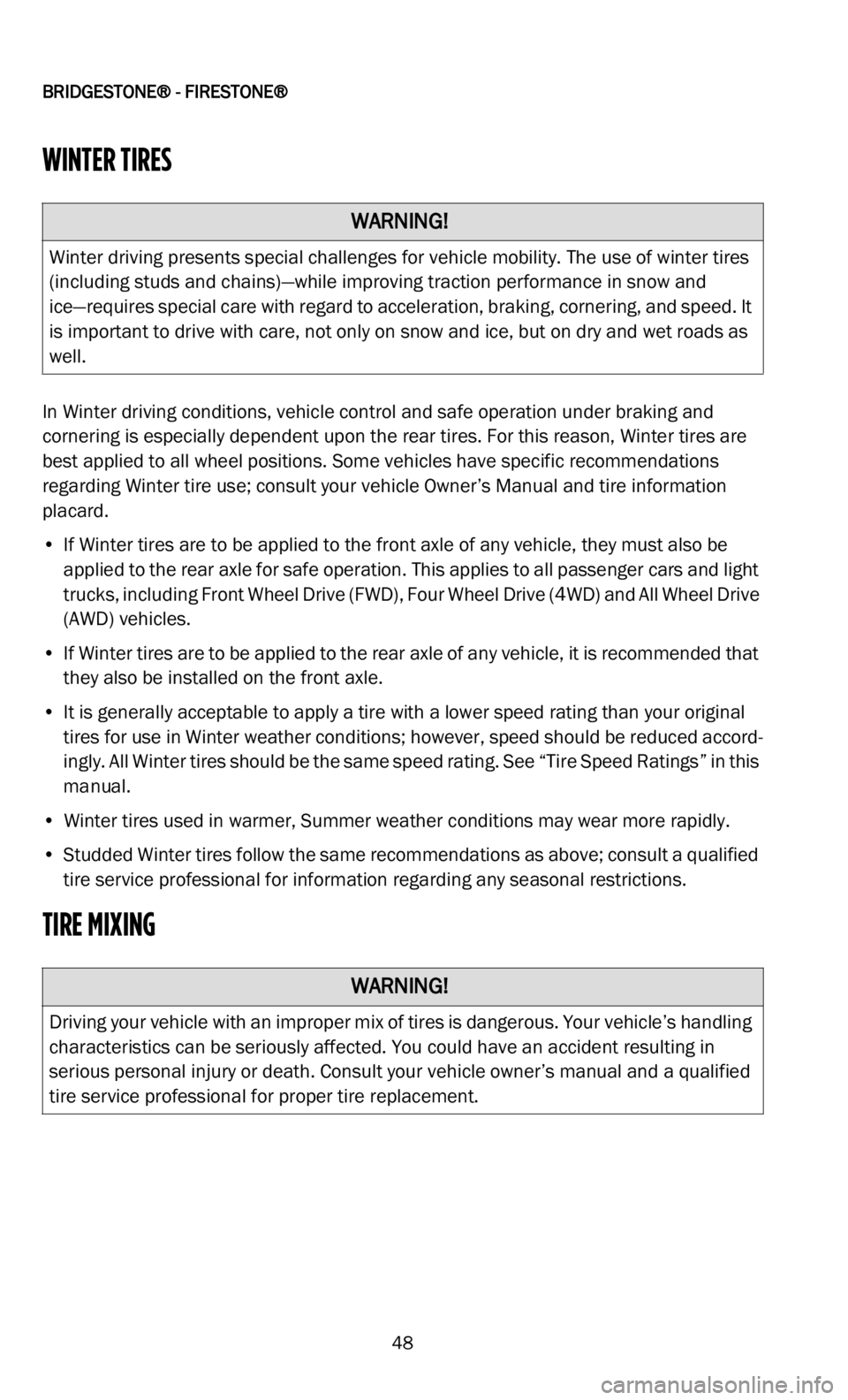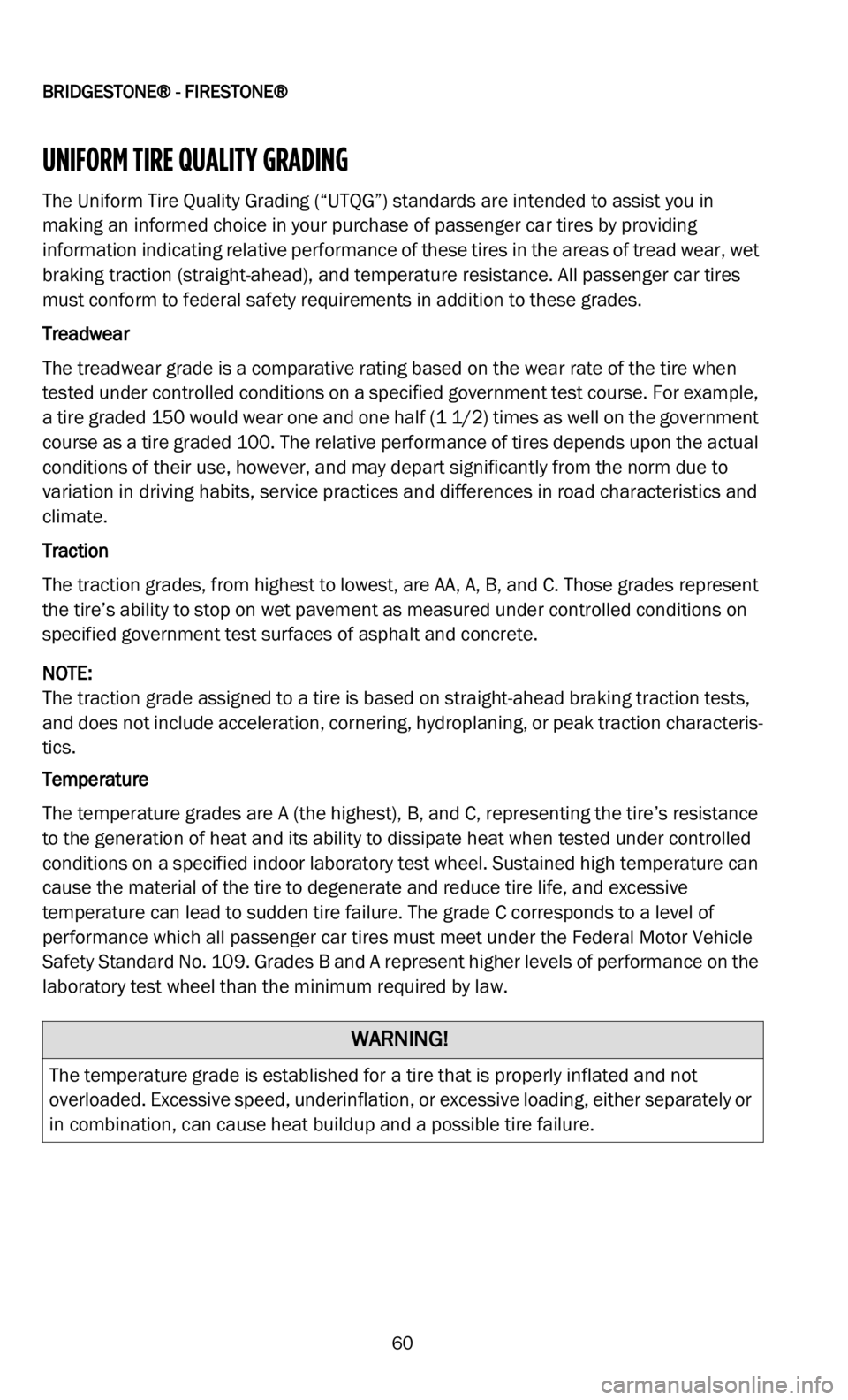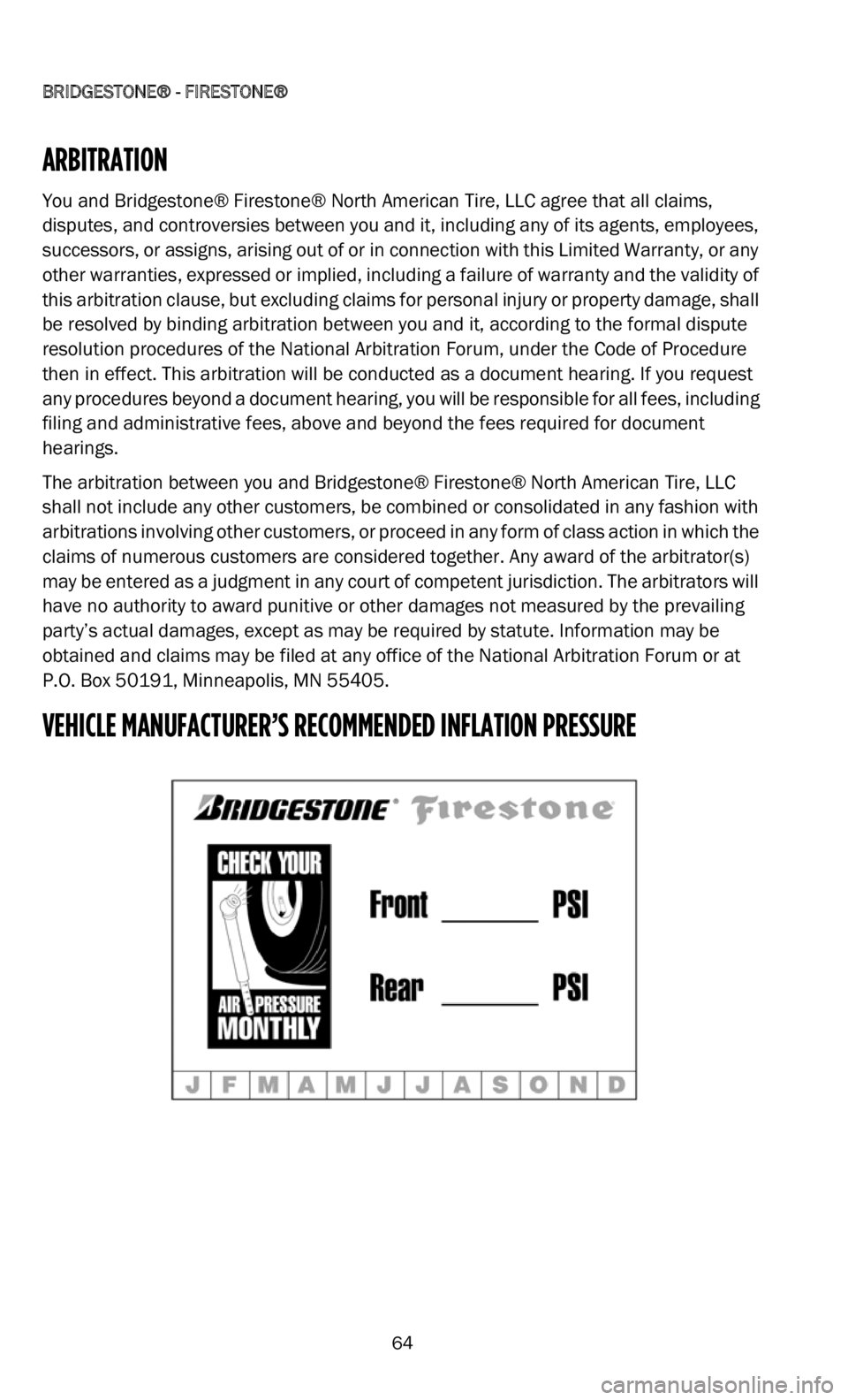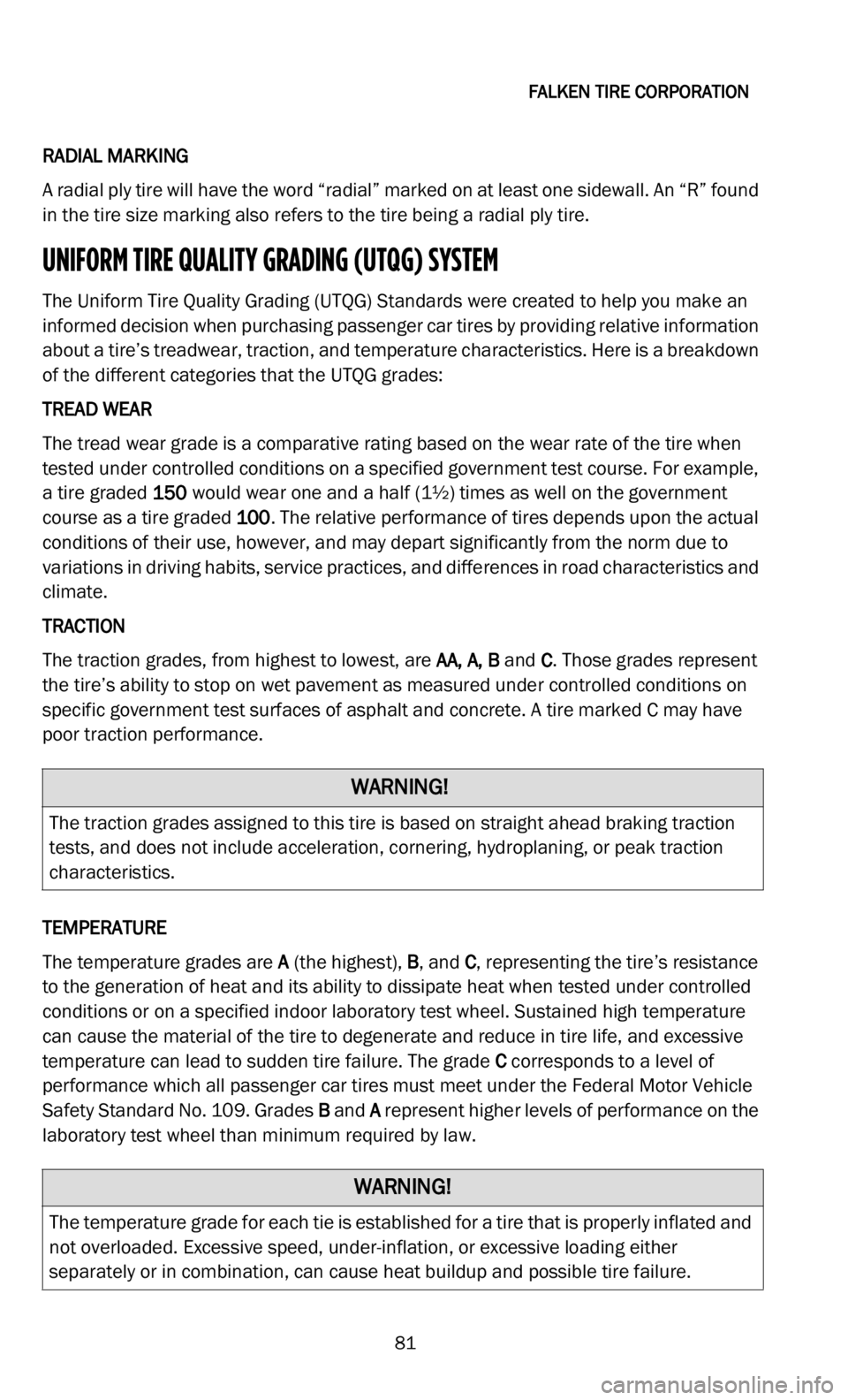ESP DODGE DURANGO 2022 Vehicle Warranty
[x] Cancel search | Manufacturer: DODGE, Model Year: 2022, Model line: DURANGO, Model: DODGE DURANGO 2022Pages: 200, PDF Size: 6.72 MB
Page 48 of 200

BRIDGESTONE® - FIRESTONE®
47
This manual is not intended to provide proper training or service procedures for tire
mounting, demounting, balancing, rotation, or repair. Please leave these tasks to
qualified tire service professionals. For your safety and that of others:
• A lways stand well clear of any tire mounting operation. This is especially important
w
hen the service operator inflates the tire. If the tire has been improperly mounted, it
may burst with explosive force causing serious personal injury or death.
• T ires must match the width and diameter requirements of the wheels. For example,
1
6 inch diameter tires must only be mounted to 16 inch diameter wheels. Radial tires
m u
st only be mounted to wheels approved for radial tires.
• W heels must be free of cracks, dents, chips, and rust. Tires must be free of bead
d
amage, cuts, and punctures.
• N ever inflate a tire beyond 40 psi (275 kPa) to seat the beads. Be absolutely certain
b
eads are fully seated before adjusting inflation pressure to the level recommended
for vehicle operation.
• N ever put flammable substances in tire/wheel assemblies at any time. Never put any
f
lammable substance into a tire/wheel assembly and attempt to ignite to seat the
beads.
• A lways stand well away from the work area when tires are being spin balanced either
o
n or off the vehicle.
HIGH PERFORMANCE, LOW ASPECT RATIO TIRES
Many new vehicles come equipped from the factory with high performance and/or low
aspect ratio tires. Generally, these tires provide increased vehicle handling capability,
but may also have numerous engineering performance trade-offs associated with their
designs.
• Lo w aspect ratio tires, with reduced sidewall height, may be more susceptible to
d
amage from potholes, road hazards, and other objects such as curbs. This is true for
the wheels as well. Therefore, as with all other tires, it is important to drive with care
and maintain proper inflation pressure and load conditions. See “Tire Inflation Pres -
sure” and “Tire Damage, Inspection and Service Life” in this manual.
• Some sports cars and other handling performance enhanced vehicles, including s
edans and light trucks/SUVs, may be originally equipped with high performance tires
that are more optimized for warmer weather use. Colder, winter weather traction may
be reduced for these types of tires. Winter tires may be recommended by the vehicle
manufacturer for colder weather application. See “Winter Tires,” the next section in
this manual.
• H igh performance tires may also wear more quickly, ride more firmly, and produce
m
ore noise during operation.
Consult your vehicle Owner’s Manual and tire information placard, or a qualified tire
s e
rvice professional, for more information and specifics regarding these types of tires.
Page 49 of 200

BRIDGESTONE® - FIRESTONE®
48
WINTER TIRES
In Winter driving conditions, vehicle control and safe operation under braking and
cornering is especially dependent upon the rear tires. For this reason, Winter tires are
best applied to all wheel positions. Some vehicles have specific recommendations
regarding Winter tire use; consult your vehicle Owner’s Manual and tire information
placard.
• If Winter tires are to be applied to the front axle of any vehicle, they must also be a
pplied to the rear axle for safe operation. This applies to all passenger cars and light
trucks, including Front Wheel Drive (FWD), Four Wheel Drive (4WD) and All Wheel Drive
(AWD) vehicles.
• I f Winter tires are to be applied to the rear axle of any vehicle, it is recommended that
t
hey also be installed on the front axle.
• I t is generally acceptable to apply a tire with a lower speed rating than your original
t
ires for use in Winter weather conditions; however, speed should be reduced accord -
ingly. All Winter tires should be the same speed rating. See “Tire Speed Ratings” in this
m a
nual.
• W inter tires used in warmer, Summer weather conditions may wear more rapidly.
•
Studded Winter tires follow the same recommendations as above; consult a qualified
t
ire service professional for information regarding any seasonal restrictions.
TIRE MIXING
WARNING!
Winter driving presents special challenges for vehicle mobility. The use of winter tires
(including studs and chains)—while improving traction performance in snow and
ice—requires special care with regard to acceleration, braking, cornering, and speed. It
is important to drive with care, not only on snow and ice, but on dry and wet roads as
well.
WARNING!
Driving your vehicle with an improper mix of tires is dangerous. Your vehicle’s handling
characteristics can be seriously affected. You could have an accident resulting in
serious personal injury or death. Consult your vehicle owner’s manual and a qualified
tire service professional for proper tire replacement.
Page 61 of 200

BRIDGESTONE® - FIRESTONE®
60
UNIFORM TIRE QUALITY GRADING
The Uniform Tire Quality Grading (“UTQG”) standards are intended to assist you in
making an informed choice in your purchase of passenger car tires by providing
information indicating relative performance of these tires in the areas of tread wear, wet
braking traction (straight-ahead), and temperature resistance. All passenger car tires
must conform to federal safety requirements in addition to these grades.
Treadwear
The treadwear grade is a comparative rating based on the wear rate of the tire when
te
sted under controlled conditions on a specified government test course. For example,
a tire graded 150 would wear one and one half (1 1/2) times as well on the government
course as a tire graded 100. The relative performance of tires depends upon the actual
conditions of their use, however, and may depart significantly from the norm due to
variation in driving habits, service practices and differences in road characteristics and
climate.
Traction
The traction grades, from highest to lowest, are AA, A, B, and C. Those grades represent
t h
e tire’s ability to stop on wet pavement as measured under controlled conditions on
specified government test surfaces of asphalt and concrete.
NOTE:
The traction grade assigned to a tire is based on straight-ahead braking traction tests,
an
d does not include acceleration, cornering, hydroplaning, or peak traction characteris -
tics.
Temperature
The temperature grades are A (the highest), B, and C, representing the tire’s resistance
t o
the generation of heat and its ability to dissipate heat when tested under controlled
conditions on a specified indoor laboratory test wheel. Sustained high temperature can
cause the material of the tire to degenerate and reduce tire life, and excessive
temperature can lead to sudden tire failure. The grade C corresponds to a level of
performance which all passenger car tires must meet under the Federal Motor Vehicle
Safety Standard No. 109. Grades B and A represent higher levels of performance on the
laboratory test wheel than the minimum required by law.
WARNING!
The temperature grade is established for a tire that is properly inflated and not
overloaded. Excessive speed, underinflation, or excessive loading, either separately or
in combination, can cause heat buildup and a possible tire failure.
Page 65 of 200

BRIDGESTONE® - FIRESTONE®
64
ARBITRATION
You and Bridgestone® Firestone® North American Tire, LLC agree that all claims,
disputes, and controversies between you and it, including any of its agents, employees,
successors, or assigns, arising out of or in connection with this Limited Warranty, or any
other warranties, expressed or implied, including a failure of warranty and the validity of
this arbitration clause, but excluding claims for personal injury or property damage, shall
be resolved by binding arbitration between you and it, according to the formal dispute
resolution procedures of the National Arbitration Forum, under the Code of Procedure
then in effect. This arbitration will be conducted as a document hearing. If you request
any procedures beyond a document hearing, you will be responsible for all fees, including
filing and administrative fees, above and beyond the fees required for document
hearings.
The arbitration between you and Bridgestone® Firestone® North American Tire, LLC
sh
all not include any other customers, be combined or consolidated in any fashion with
arbitrations involving other customers, or proceed in any form of class action in which the
claims of numerous customers are considered together. Any award of the arbitrator(s)
may be entered as a judgment in any court of competent jurisdiction. The arbitrators will
have no authority to award punitive or other damages not measured by the prevailing
party’s actual damages, except as may be required by statute. Information may be
obtained and claims may be filed at any office of the National Arbitration Forum or at
P.O. Box 50191, Minneapolis, MN 55405.
VEHICLE MANUFACTURER’S RECOMMENDED INFLATION PRESSURE
Page 69 of 200

CONTINENTAL TIRE
68
ATTENTION AUTHORIZED DEALERS: CONTINENTAL TIRE THE AMERICAS, LLC (CTA)
RESERVES THE RIGHT TO THE FINAL INSPECTION DECISION FOR ALL RETURNED TIRES
ON CONDITIONS UNDER SECTION 3.
THIS WARRANTY IS MADE IN LIEU OF ALL OTHER WARRANTIES, EXPRESS OR IMPLIED,
AN
D CTA EXPRESSLY DISCLAIMS ALL IMPLIED WARRANTIES, INCLUDING, BUT NOT
LIMITED TO, WARRANTIES OF MERCHANTABILITY OR FITNESS FOR A PARTICULAR
PURPOSE. SOME US AND/OR CANADIAN PROVINCES DO NOT ALLOW LIMITATIONS ON
THE DURATION OF AN IMPLIED WARRANTY, SO THE ABOVE MAY NOT APPLY TO YOU.
TO THE EXTENT PERMITTED BY LAW, CTA DISCLAIMS LIABILITY FOR ALL
CO
NSEQUENTIAL AND INCIDENTAL DAMAGES. THE REMEDIES SET FORTH IN THIS
LIMITED WARRANTY ARE THE SOLE AND EXCLUSIVE REMEDIES FOR BREACH OF
WARRANTY. SOME US AND/OR CANADIAN PROVINCES DO NOT ALLOW THE EXCLUSION
OR LIMITATION OF INCIDENTAL OR CONSEQUENTIAL DAMAGES, SO THE ABOVE
LIMITATION OR EXCLUSION MAY NOT APPLY TO YOU. THIS WARRANTY GIVES YOU
SPECIFIC LEGAL RIGHTS, AND YOU MAY ALSO HAVE OTHER RIGHTS WHICH VARY FROM
US STATE TO STATE AND/OR CANADIAN PROVINCE TO PROVINCE.
THIS IS THE ONLY EXPRESS WARRANTY MADE BY CTA. NO CTA EMPLOYEE, RETAILER,
O R
DEALER HAS THE AUTHORITY TO MAKE ANY WARRANTY, REPRESENTATION,
PROMISE OR AGREEMENT ON BEHALF OF CTA EXCEPT AS EXPRESSLY WRITTEN IN THIS
LIMITED WARRANTY AND ADJUSTMENT POLICY. IN OBSERVANCE OF US FEDERAL LAW,
THIS LIMITED WARRANTY AND ADJUSTMENT POLICY HAS BEEN DESIGNATED A “LIMITED
WARRANTY”. CTA DOES NOT INTEND TO REPRESENT THROUGH THIS LIMITED
WARRANTY AND ADJUSTMENT POLICY THAT TIRE FAILURES CAN OR CANNOT HAPPEN.
CTA’S OBLIGATIONS
Replacement of eligible tires will be made by the dealer where you purchased your
v e
hicle or by an alternate Authorized Dealer. CTA will replace the tire pursuant to the
terms of this Warranty. Tires that are replaced under this Warranty become the property
of CTA.
OWNER’S OBLIGATIONS
To make an eligible claim under this Warranty, the owner must present a claim, with the
t i
re to an Authorized Dealer. For the nearest Authorized Dealer, consult the Continental
brand internet address(es), or the 800 telephone number(s) located in the back of this
warranty section.
Owner must present new vehicle registration form or new vehicle sales invoice indicating
t h
e date of purchase. Owner will be required to sign the CTA Limited Warranty Claim Form
or dealer replacement sales receipt.
Owner is responsible for paying all applicable taxes charged by the servicing dealer and
i s
also responsible for paying shipping, local tire-disposal fees and parts or service
Page 70 of 200

CONTINENTAL TIRE
69
regardless of mileage or months of service. This includes payment for tire rotation,
alignment, towing, road service, valve stems and tire repairs.
Owner is responsible for maintaining proper tire air pressure and for proper maintenance
o f
the tire.
SAFETY WARNING:
Ignoring any of the safety and information contained in this warranty may result in tire
f a
ilure, causing serious injury or death.
• Tire failure due to underinflation/overloading.
Follow vehicle Owner’s Manual or tire
placard in vehicle for proper inflation and loading.
• Explosion of tire/rim assembly due to improper tire mounting.
Tire mounting/
demounting can be dangerous. It should be performed only by a trained tire specialist
using proper tools and procedures. Prior to tire mounting/demounting, the US Tire
Manufacturers Association (USTMA) wall charts and manuals should be read to obtain
the proper procedures. The failure to follow these procedures may result in faulty posi -
tioning of the tire and/or rim, which may cause the assembly to burst with force suffi -
cient to cause injury or death.
• T
ire failure due to damage.
Inspect your tires frequently for scrapes, bulges, separa -
tions, cuts, snags and other damage from road hazards. Damage from impact can
o c
cur to the inner portions of your tire without being visible to the outside. If you
suspect a tire has been damaged from striking anything unusual in the road, you must
have the tire removed from the rim and inspected both inside and out by a trained tire
specialist. Air loss or unusual tire wear can also be warning signs that a tire may have
internal damage. If you notice these conditions, have your tire inspected by a trained
individual.
• T ire failure due to excessive tire spinning. A
void tire spinning. The centrifugal force
generated by a free-spinning tire/rim assembly may cause a sudden tire explosion
resulting in vehicle damage and/or serious injury or death. Never exceed 35 mph
( 5
5km/h) as indicated on your speedometer when your vehicle is stuck in snow, mud,
or sand and your tire(s) is/are spinning. Use a gentle backward and forward rocking
motion to free your vehicle for continued driving. Never stand or permit anyone else to
stand near or behind a tire spinning while attempting to push a vehicle that is stuck.
SELF SUPPORTING RUNFLAT (SSR) TIRE OWNERS
Continental Tire the Americas, LLC (CTA) does not recommend any repair to or reuse of
punctured Continental SSR tires.
Even a trained tire specialist may be unable to recognize internal structural damage to a
S e
lf Supporting Run-flat (SSR) tire resulting from having been driven in an under inflated
or zero inflation pressure condition. Such damage may not be visible on the surface of
the inner liner or sidewall making it impossible to determine the tire suitability for repair
or reuse. CTA does not recommend any repair to or reuse of Continental SSR tires. You
may visit https://www.continentaltire.com/ or www.continentaltire.ca and select
Customer Care FAQs to obtain additional SSR information.
Page 78 of 200

FALKEN TIRE CORPORATION
77
B) LIMITED WARRANTY
This limited warranty applies to Falken brand original equipment passenger car,
temporary spare, and light truck steel belted radial tires bearing the complete
description and serial number required by the Department of Transportation (DOT). This
warranty is effective only to tires for which claims are made within five years of the date
of production, based on the tire DOT serial number.
1. WHAT IS COVERED AND FOR HOW LONG
Falken tires that are originally equipped on this vehicle are warranted against
any defects in the materials and workmanship for the usable life of the original
tread. The limited warranty terminates at the flush appearance of the tread wear
indicators at 1.6 mm (2/32 of an inch) remaining tread depth.
• Free Replacement - If a tire becomes unserviceable due to such defect within the
first 1.6 mm (2/32 of an inch) of tread wear, the tire will be replaced free of charge
w i
th the same or comparable Falken tire.
• P rorated Replacement - After the first 1.6
mm (2/32 of an inch) of wear, a prorated
ad
justment credit will be given based on the percentage of remaining usable tread
depth, down to the remaining 1.6 mm (2/32 of an inch) tread wear bar indicator.
N o
credit is given if the tire is worn beyond the flush appearance of the tread wear
bar indicator (less than 1.6 mm (2/32 of an inch) tread depth remaining).
• O ut-of-Round/Out-of-Balance Replacement- Tires that are deemed to be
o
ut-of-round or out-of-balance will be accepted for adjustment during the first
0.8 mm (1/32 of an inch) of the original tread depth and will be replaced free of
c h
arge with the same or similar Falken tires (no labor costs will be covered). A set
of four (4) tires from the same vehicle will not be accepted for out-of-round or
out-of-balance claims.
2. W HAT IS NOT COVERED BY THE WARRANTY
•
Tires that become unserviceable due to road hazard damages (cuts, snags, punc -
t
ures, bruises, impact breaks, etc.) improper repair technique or materials,
i m
proper inflation, overload, irregular wear, wheel imbalance, defective mechan -
ical vehicle components (brakes, suspension, wheels, etc.) improper suspension
a l
ignment, accident, fire, chemical damage, damage from chain use, racing,
off-road use, run flat, improper installation, vandalism, or abuse.
• T ires branded “NA” or a tire in which the DOT numbering has been removed.
•
Tires presented for a warranty claim by someone other than by someone other
t
han the original purchaser, or tires that were transferred to another vehicle from
the vehicle on which the tires were originally installed.
• T ires having a failure or failures caused by previous damages or repairs.
•
The cost of tire repair or retreading is not covered by this warranty and will be the
s
ole responsibility of the tire owner.
Page 79 of 200

FALKEN TIRE CORPORATION 78
Possible non-Covered Reasons/Conditions:
3. OWNER’S OBLIGATIONS
At least monthly, the vehicle owner(s) should check the tires’ air pressure with a
gauge and inflate to the recommended cold air pressure level listed on the driver
door placard. Do not rely on car servicers to perform the checks. The tires should
be rotated at least every 8,000 km (5,000 miles) or earlier if uneven wear is oc -
curring, and proof of maintenance records should be kept. The owner(s) should
h a
ve the tires rebalanced if vibration is experienced, and the vehicle’s alignment
should be checked if uneven or rapid wear is occurring, or when suggested by
the vehicle’s manufacturer.
All warranty claims must be presented to an authorized Falken dealer or partici -
pating car dealership. The owner(s) must present any supporting maintenance
r e
cords and documentation necessary to help determine if the tire(s) in question
are deemed covered by the limited warranty or not.
4. LEGAL RIGHTS
All implied warranties, including warranties of merchantability and fitness for a
particular purpose shall be limited in duration to the above period. To the extent
permitted by law, Falken Tire Corporation shall not be responsible for incidental
or consequential damages, such as loss of use of the tire or the vehicle on which
it is used, inconvenience, or commercial loss, some states do not allow limita -
tions on how long an implied warranty lasts, or the exclusion or limitation of inci -
dental or consequential damages, so the above limitations or exclusions may not
a p
ply to you. This warranty gives you specific legal rights and you may also have
other rights, which vary from state to state. This is the only express warranty ap -
plicable to Falken brand tires and supersedes the terms of any previous warran -
ty. Falken neither assumes nor authorizes anyone to make or assume for it any
o t
her warranty.
Chipping/Chunking/Tearing Puncture
Corrosion/Wreck Racing or any Competition
Fire Repair Failure
Impact Break or Concussions Road Hazards
Improper Inflation Pressure Sidewall Cut or Damage
Improper Mounting/Dismount Theft or Vandalism
Mechanical Defects of the Vehicle Tread Cuts
Misalignment Wheel Imbalance
Misapplication Willful Abuse
Overloading
Page 82 of 200

FALKEN TIRE CORPORATION
81
RADIAL MARKING
A radial ply tire will have the word “radial” marked on at least one sidewall. An “R” found
i n
the tire size marking also refers to the tire being a radial ply tire.
UNIFORM TIRE QUALITY GRADING (UTQG) SYSTEM
The Uniform Tire Quality Grading (UTQG) Standards were created to help you make an
informed decision when purchasing passenger car tires by providing relative information
about a tire’s treadwear, traction, and temperature characteristics. Here is a breakdown
of the different categories that the UTQG grades:
TREAD WEAR
The tread wear grade is a comparative rating based on the wear rate of the tire when
te
sted under controlled conditions on a specified government test course. For example,
a tire graded 150 would wear one and a half (1½) times as well on the government
course as a tire graded 100. The relative performance of tires depends upon the actual
conditions of their use, however, and may depart significantly from the norm due to
variations in driving habits, service practices, and differences in road characteristics and
climate.
TRACTION
The traction grades, from highest to lowest, are AA
, A, B and C. Those grades represent
the tire’s ability to stop on wet pavement as measured under controlled conditions on
specific government test surfaces of asphalt and concrete. A tire marked C may have
poor traction performance.
TEMPERATURE
The temperature grades are A
(the highest), B, and C, representing the tire’s resistance
to the generation of heat and its ability to dissipate heat when tested under controlled
conditions or on a specified indoor laboratory test wheel. Sustained high temperature
can cause the material of the tire to degenerate and reduce in tire life, and excessive
temperature can lead to sudden tire failure. The grade C corresponds to a level of
performance which all passenger car tires must meet under the Federal Motor Vehicle
Safety Standard No. 109. Grades B and A represent higher levels of performance on the
laboratory test wheel than minimum required by law.
WARNING!
The traction grades assigned to this tire is based on straight ahead braking traction
tests, and does not include acceleration, cornering, hydroplaning, or peak traction
characteristics.
WARNING!
The temperature grade for each tie is established for a tire that is properly inflated and
not overloaded. Excessive speed, under-inflation, or excessive loading either
separately or in combination, can cause heat buildup and possible tire failure.
Page 91 of 200

GENERAL TIRE
90
(“Authorized Dealer”). CTNA will replace the tire pursuant to the terms of this Limited
Warranty and Adjustment Policy. Tires that are replaced under an adjustment basis
under this Limited Warranty and Adjustment Policy become the property of CTNA.
OWNER’S OBLIGATIONS
To make an eligible claim under this Limited Warranty and Adjustment Policy, the owner
must present a claim with the tire to an authorized dealer. For the nearest authorized
dealer, consult the Yellow Pages, the General brand internet address, or the 800 telephone
numbers shown on the back of this Limited Warranty and Adjustment Policy. Owner must
present new vehicle registration form or new vehicle sales invoice indicating the date of
purchase. Owner will be required to sign the CTNA Limited Warranty Claim Form or dealer
replacement sales receipt.
Owner is responsible for paying all applicable taxes set forth under this Limited Warranty
and
Adjustment Policy. Owner is also responsible for paying local tire disposal fees and any
parts or service regardless of mileage or months of service. This includes payment for tire
rotation, alignment, towing, road service, valve stems and tire repairs. Owner is
responsible for maintaining proper tire air pressure and for proper maintenance of the tire.
SAFETY WARNING:
Ignoring any of the safety and information contained in this limited warranty and
Adjustment Policy may result in tire failure, causing serious injury or death.
• Tire failure due to underinflation/overloading.
Follow vehicle Owner’s Manual or tire
placard in vehicle for proper inflation and loading.
• Explosion of tire/rim assembly due to improper tire mounting.
Tire mounting /
demounting can be dangerous. It should be performed only by a trained tire specialist
using proper tools and procedures. Prior to tire mounting/demounting, the Rubber
Manufacturers Association (RMA) wall charts and manuals should be read to obtain
the proper procedures. The failure to follow these procedures may result in faulty posi -
tioning of the tire and/or rim, which may cause the assembly to burst with force suffi -
cient to cause injury or death.
• T
ire failure due to damage.
Inspect your tires frequently for scrapes, bulges, separations,
cuts, snags and other damage from road hazards. Damage from impact can occur to the
inner portions of your tire without being visible to the outside. If you suspect a tire has
been damaged from striking anything unusual in the road, you must have the tire
removed from the rim and inspected both inside and out by a trained tire specialist. Air
loss or unusual tire wear can also be warning signs that a tire may have internal damage.
If you notice these conditions, have your tire inspected by a trained individual.
• Tire failure due to excessive tire spinning.
Avoid tire spinning. The centrifugal force
generated by a free-spinning tire/rim assembly may cause a sudden tire explosion
resulting in vehicle damage and/or serious injury or death. Never exceed 35 mph
( 5
5 km/h) as indicated on your speedometer when your vehicle is stuck in snow, mud,
o r
sand and your tire(s) is/are spinning. Use a gentle backward and forward rocking
motion to free your vehicle for continued driving. Never stand or permit anyone else to
stand near or behind a tire spinning while attempting to push a vehicle that is stuck.